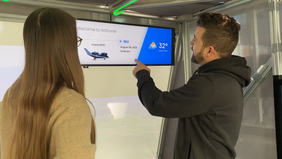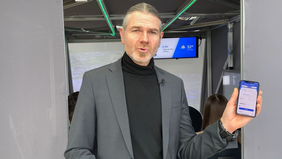Flying from Munich to Ingolstadt by air taxi and buying the ticket and checking in conveniently via app. What sounds like a vision of the future, students of the Master's programme "User Experience Design" (UXD) at Technische Hochschule Ingolstadt (THI) wanted to implement as practically as possible. To this end, they built the prototype of a passenger drone, with which the entire process from booking a seat to carrying out the flight can be represented. The prototype has four seats and was constructed on a scale of 1:1. However, the aim is not for the "AirDrone" to take off one day, but to classify the experiences of a user during a simulated flight. To ensure that the results have long-term benefits, Professor Andreas Riener, head of the "User Experience Design" (UXD) course, attached great importance to ensuring that all steps were implemented as realistically as possible.
What is important to passengers?
The prototype should illustrate which concepts and visualisations are needed on board, which might even influence the construction later on. The topic of seat selection was particularly exciting: "Because of the sensitivity of weight, it will not be possible to seat two heavy people on the left and two light people on the right," explains Professor Riener. The booking app, where seat selection was originally possible, had to be adapted again to this end. Since drones have a lower altitude and a lower dead weight compared to passenger aircraft, the flight is more jerky, which affects acceptance.
Other important findings include preferences for carrying luggage: Due to the weight issue, it was examined to what extent it would be acceptable to carry heavier luggage on the ground - separate from the passenger. The result was: the majority of passengers would like to carry their luggage with them at all times, even at a higher price. Another acceptance issue is the remote monitoring (teleoperation) of the drone from a control centre, instead of a pilot on board as currently envisaged. Studies are currently being conducted to find out the attitudes of potential passengers and to develop the necessary information and interaction concepts.
Taking a seat in the passenger drone
While the student project has been completed, the public funding project is still ongoing. Based on the findings, research assistant Patricia Appel will continue to work on safety aspects of passenger drones as part of her doctorate. In addition, the public will soon be able to take a seat in the prototype themselves. "We are currently still fine-tuning it and will then use the prototype at the THI's University Information Day on 25 March as well as at the ON Campus Festival on 16 June and at the IAA in autumn," says Professor Riener.
He concludes by emphasising that the project is linked to the model project "Urban Air Mobility" in the Ingolstadt region and the brigkAir start-up programmes. The "Prototyp-Bau" project is also docked to the joint project "AMI-Airshuttle". This project develops solutions for the operation of so-called vertiports, i.e. a new type of infrastructure, at airports. The integration of electrified air taxis including operating concepts is being tested.



![[Translate to English:] Logo Akkreditierungsrat: Systemakkreditiert](/fileadmin/_processed_/2/8/csm_AR-Siegel_Systemakkreditierung_bc4ea3377d.webp)








![[Translate to English:] Logo IHK Ausbildungsbetrieb 2023](/fileadmin/_processed_/6/0/csm_IHK_Ausbildungsbetrieb_digital_2023_6850f47537.webp)


